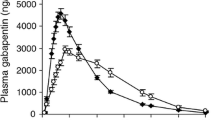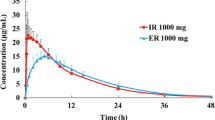Abstract
This review analyses the concept of extended-release (ER) formulations in epilepsy and evaluates ER formulations of carbamazepine, valproic acid and a modified-release (MR) formulation of oxcarbazepine. ER formulations are usually designed to reduce dose frequency and maintain relatively constant or flat plasma drug concentration. It is questionable whether flat plasma concentrations of an antiepileptic drug (AED) improve antiepileptic efficacy compared with fluctuating plasma concentrations. More certainly, they minimise concentration-related adverse effects, and the dosing flexibility and consistency of plasma concentrations may simplify the management of antiepileptic drug therapy.
Neurologists would like ER formulations that can be administered once- and/ or twice-daily to tailor therapy for the individual patient; however, switching dosage schedules from multiple dosages per day to once daily, although more convenient, will not generally improve therapeutic coverage (maintenance of effective drug concentration in biological fluids and tissue). Pharmacokinetically, the impact of a missed dose is greater the larger the dose and the less frequent the administration. Therefore, the risk of breakthrough seizure is higher during AED once-daily administration than twice-daily administration. Consequently, the increased compliance observed with fewer dosages per day should be weighed against the impact or forgiveness of omitted dose(s) and the shorter ‘forgiveness’ period associated with once-daily administration.
Currently, the trend is to treat patients with epilepsy with ER formulations because of the better compliance, convenience and flat plasma concentration versus time curve. Thus, it seems that the term ‘flatter is better’ for AED plasma profiles has precipitated in the last 10–15 years among neurologists and epilepsy caregivers, and is being promoted by marketing forces of pharmaceutical companies. Data from the literature support the trend to treat epileptic patients with twice-daily administration of the existing ER formulations of valproic acid and carbamazepine, and oxcarbazepine-MR; however, the author of this article is not convinced that these ER formulations can guarantee a complete therapeutic coverage throughout the 24-hour dosing interval following once-daily administration.
Epilepsy is a single-episode disease, and the convenience and possible better compliance associated with once-daily administration must be weighed against the shorter ‘forgiveness’ period and possible higher risk of breakthrough seizure due to sub-therapeutic plasma levels and/or omitted doses. Data suggest just a small difference in compliance between once- and twice-daily administration, with no significant difference in efficacy. Therefore, the increased compliance following once-daily administration may be counter-productive in minimising the occurrence of sub-therapeutic drug concentrations. Weighing up the advantages and disadvantages for once-versus twice-daily administration of ER formulations in epilepsy leads to a conclusion in favour of twice-daily administration.
Similar content being viewed by others
Notes
The use of trade names is for product identification purposes only and does not imply endorsement.
References
Bialer M, Friedman M, Dubrovsky J, et al. Pharmacokinetic evaluation of novel sustained-release dosage forms of valproic acid in humans. Biopharm Drug Dispos 1985; 6: 401–11
Hussein Z, Bialer M, Friedman M, et al. Pharmacokinetic analysis of sustained release dosage forms of theophylline in humans: comparison of single and multiple dose studies. Biopharm Drug Dispos 1987; 8: 427–35
Bialer M, Sussan S, Abu Salach O, et al. Criteria to assess in vivo performance of sustained release products: application to diltiazem formulations. J Pharm Sci 1995; 84: 1160–3
Bialer M, Yacobi A, Moros D, et al. Criteria to assess in vivo performance and bioequivalence of generic controlled release (CR) formulations of carbamazepine. Epilepsia 1998; 39: 513–9
Bialer M, Aracvi L, Sussan S, et al. Existing and new criteria for bioequivalence evaluation of controlled release (CR) products of carbamazepine. Epilepsy Res 1998; 32: 371–8
Bialer M. Pharmacokinetic evaluation of sustained-release formulations of antiepileptic drugs. Clin Pharmacokinet 1992; 22: 11–21
Bialer M, Cloyd JC. General principles: formulations and routes of administration. In: Levy RH, Mattson RH, Meldrum BS, editors. Antiepileptic drugs. 4th ed. New York; Raven Press, 1995: 161–78
Benet LZ, Hoener B. Changes in plasma protein binding have little clinical relevance. Clin Pharmacol Ther 2002; 71: 115–21
Bialer M, Friedman M, Rubinstein A, et al. Pharmacokinetic evaluation of novel sustained-release dosage forms of valproic acid, and i.V. preparation of valpromide in dogs. In: Levy RH, Pitlick WH, Eichelbaum M, et al., editors. Metabolism of antiepileptic drugs. New York; Raven Press, 1984: 143–53, and the discussion therein
Doughty J, Baker GA, Jacoby A, et al. Compliance and satisfaction with switching from an immediate-release to sustained-release formulation of valproate in people with epilepsy. Epilepsy Behav 2003; 4: 710–6
Pellock JM, Smith MC, Cloyd JC, et al. Extended-release formulation: simplifying strategies in the management of antiepileptic drug therapy. Epilepsy Behav 2005; 4: 301–7
Ficker DM, Privitera M, Krauss G, et al. Improved tolerability and efficacy in epilepsy patients with extended-release carbamazepine. Neurology 2005; 65: 593–5
Greenberg RN. Overview of patient compliance with medication dosing: a literature review. Clin Chem 1984; 6: 592–9
Cramer JA, Mattson RA, Prevey ML, et al. How often is medication taken as prescribed? JAMA 1989; 261: 3273–7
Eisen SA, Miller DK, Woodward RS, et al. The effect of prescribed daily dose frequency on patient medication compliance. Arch Intern Med 1990; 150: 1881–4
Levy G. A pharmacokinetic perspective of medicament non-compliance. Clin Pharmacol Ther 1993; 54: 242–4
Rowland M, Tozer T. Clinical Pharmacokinetics: concepts and applications. 3rd ed. Baltimore (MD); Williams & Wilkins, 1995: 83–103
Urquhart J. Ascertaining how much compliance is enough with outpatient antibiotic regimens. Postgrad Med J 1992; 68Suppl. 3: S49–59
Urquhart J. The electronic medication event monitor: lessons for pharmacotherapy. Clin Pharmacokinet 1997; 32: 345–56
Urquhart J. Pharmacodynamics of variable patient compliance: implications for pharmaceutical value. Adv Drug Deliv Rev 1998; 33: 207–19
Royer-Morrot M-J, Zhiri A, Jacob F, et al. Influence of food intake on the pharmacokinetics of a sustained release formulation of sodium valproate. Biopharm Drug Dispos 1993; 14: 511–8
Roberts D, Easter D, O’Bryan-Tear G. Epilim chrono: a multidose, crossover comparison of two formulations of valproate in healthy volunteers. Biopharm Drug Dispos 1996; 17: 175–82
Herranz JL, Arteaga R, Adin J, et al. Conventional and sustained-release valproate in children with newly diagnosed epilepsy: a randomized and crossover study comparing clinical effects, patients preference and pharmacokinetics. Eur J Clin Pharmacol 2006; 62: 805–15
Dulac O, Alvarez J-C. Bioequivalence of a new sustained-release formulation of sodium valproate, valproate modified-release granules, compared with existing sustained-release formulations after once- or twice-daily administration. Pharmacotherapy 2005; 25: 35–41
Retzow A, Vens-Cappell B, Wangemann M. Influence of food on the pharmacokinetics of a new multiple unit sustained release sodium valproate formulation. Arzneimittelforschung 1997; 47(12): 1347–50
Dutta S, Reed RC. A multiphasic absorption model best characterizes gastrointestinal absorption of divalproex extended-release. J Clin Pharmacol 2006; 46: 952–7
Bialer M, Johannessen SJ, Kupferberg HJ, et al. Progress report on new antiepileptic drugs: a summary of the 8th Eilat Conference (EILAT VIII). Epilepsy Res 2007; 73: 1–52
Dutta S, Reed RC. Comparison of the absorption characteristics of five oral formulations of valproic acid: clinical impact [abstract/poster no. 1.077]. Joint Annual Meeting of the American Epilepsy Society (AES) and the American Clinical Neurophysiology Society, 2005 Dec 4. Epilepsia 2005; 46Suppl. 8: 39
Dutta S, Zhang Y. Bioavailability of divalproex extended-release formulation relative to the divalproex delayed-release formulation. Biopharm Drug Dispos 2004; 25: 345–52
Dutta S, Reed RC, Cavanaugh JH. Absolute bioavailability and absorption characteristics of divalproex sodium extended-release tablets in healthy volunteers. J Clin Pharmacol 2004; 44: 737–42
Dutta S, Reed RC. Divalproex to divalproex extended-release conversion. Clin Drug Invest 2004; 24: 495–508
McCabe PH, Michel NC, McNew CD, et al. Conversion from delayed-release sodium valproate to extended-release sodium valproate: initial results and long-term follow-up. Epilepsy Behav 2006; 8: 601–5
Sommerville KW, Dutta S, Biton V, et al. Bioavailability of a divalproex extended-release formulation versus the conventional divalproex formulation in adult patients receiving enzyme-inducing antiepileptic drugs. Clin Drug Invest 2003; 23: 661–70
Thibault M, Blume WT, Saint-Hilaire J-M, et al. Divalproex extended-release versus the original divalproex tablet: results of a randomized, crossover study of well-controlled epileptic patients with primary generalized epilepsy. Epilepsy Res 2002; 50: 243–9
Nau H. Teratogenic valproic acid concentrations: infusions by implanted minipumps vs. conventional injection regimen in the mouse. Toxicol Appl Pharmacol 1985; 80: 243–50
Nau H. Pharmacokinetic aspects of drug teratogenesis: species differences and structure activity relationships of the anticon-vulsant valproic acid. Acta Pharm Jugosl 1990; 40: 291–300
Kondo T, Tokinga N, Suzuki A, et al. Altered pharmacokinetics and metabolism of valproate after replacement of conventional valproate with the slow-release formulation in epileptic patients. Pharmacol Toxicol 2002; 90: 135–8
Ahmad A, Garnnet WR. Simulated fluctuations in plasma drug concentrations of patients receiving oxcarbazepine or carbamazepine extended release capsules. Clin Drug Invest 2005; 25: 669–73
Riva R, Albani F, Ambrosetto G, et al. Diurnal fluctuations in free and total steady-state plasma levels of carbamazepine and correlation with intermittent side effects. Epilepsia 1984; 25: 476–81
Hoppener RJ, Kuyer A, Meijer JW, et al. Correlation between daily fluctuations of carbamazepine serum levels and intermittent side effects. Epilepsia 1980; 21: 341–50
Tomson T. Interdosage fluctuations in plasma carbamazepine concentration determine intermittent side effects. Arch Neurol 1984; 41: 830–4
Aldenkamp AP, Alpherts WC, Moerlans MC, et al. Controlled release carbamazepine: cognitive side effects in patients with epilepsy. Epilepsia 1987; 28: 507–14
Collins RJ, Garnet WR. Extended release formulations of anticonvulsant medictions: clinical pharmacokinetics and therapeutic advantages. CNS Drugs 2000; 14: 203–12
Stefan H, Schafer H, Kuhnen C, et al. Clinical monitoring during carbamazepine slow-release, once daily monotherapy. Epilepsia 1988; 29: 571–7
Thakker KM, Mangat S, Garnett WR, et al. Comparative bioavailability and steady state fluctuations of Tegretol commercials and carbamazepine Oros tablets in adult and pediatric epileptic patients. Biopharm Drug Dispos 1992; 13: 559–69
Wilding JR, Davis SS, Hardy JG, et al. Relationship between systemic drug absorption and gastrointestinal transit after the simultaneous oral administration of carbamazepine as a controlled-release system and as a suspension of 15N-labelled drug to healthy subjects. Br J Clin Pharmacol 1991; 32: 573–9
The Tegretol OROS Osmotic Release Delivery System Study Group. Double-blind crossover comparison of Tegrerol XR and Tegretol in patients with epilepsy. Neurology 1995; 45: 1703–7
Stevens RE, Limsakun T, Evans G, et al. Controlled, multidose, pharmacokinetic evaluation of two extended-release carbamazepine formulations (Carbatrol and Tegretol-XR). J Pharm Sci 1998; 87: 1531–4
Wheless JW, Venkataraman V. New formulations of drugs in epilepsy. Expert Opin Pharmacother 1999; 1: 49–60
Mirza WU, Rak IW, Thadani VM. Six-month evaluation of Carbatrol (extened-release of carbamazepine) in complex partial seizures. Neurology 1998; 19: 1727–9
Harrison TS, Keating GM. Extended-release carbamazepine capsule in bipolar I disorder. CNS Drugs 2005; 19: 709–16
Acknowledgements
No sources of funding were used to assist in the preparation of this review. The author has no conflicts of interest that are directly relevant to the content of this review.
Author information
Authors and Affiliations
Corresponding author
Rights and permissions
About this article
Cite this article
Bialer, M. Extended-Release Formulations for the Treatment of Epilepsy. CNS Drugs 21, 765–774 (2007). https://doi.org/10.2165/00023210-200721090-00005
Published:
Issue Date:
DOI: https://doi.org/10.2165/00023210-200721090-00005




